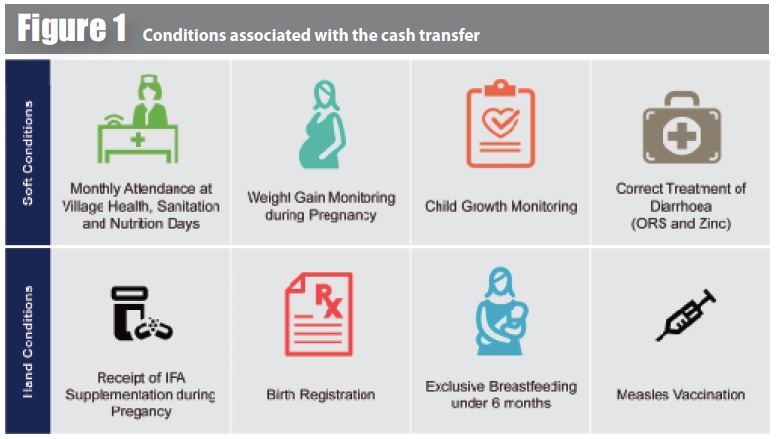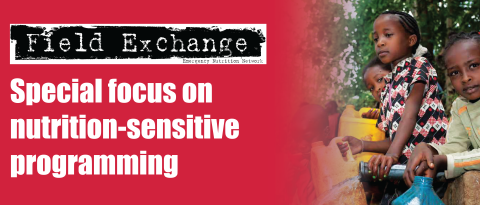Review of the micronutrient impact of multi-sectoral programmes focusing on nutrition
Summary of research1
Location: Global
What we know: Common strategies to combat micronutrient deficiencies involve supplementation and fortification, breastfeeding promotion, behaviour change and communication on complementary feeding, and reducing infectious diseases.
What this article adds: A recent paper reviewed the evidence regarding the micronutrient (MN) impact of multi-sectoral programmes that combine targeted nutrition interventions with poverty-alleviation, food security enhancement, and/or income-generating approaches. Programmes reviewed were conditional cash transfers (CCTs), microcredit with education (MCE), and agricultural interventions. The authors found limited evidence of CCT impact on children’s MN status, more consistent evidence on anthropometry, and some impact on health. No conclusions were possible on MCE impact due to a dearth of information. Agriculture impacted most notably on vitamin A status; few agriculture interventions assessed impact on child anthropometry. The majority of programmes improved household income, food availability and access. Better design, implementation and evaluation is needed to strengthen the evidence base and yield more effective programmes.
 Millions of people in low- and middle-income countries suffer from MN deficiencies as a consequence of monotonous diets based on plant-based staple foods. MN deficiencies affect the survival, health, development, and wellbeing of individuals, especially children and women of reproductive age. The most commonly used strategies to combat MN deficiencies are MN supplementation and fortification, breastfeeding promotion, behaviour change and communication (BCC) strategies to improve complementary feeding practices, and health interventions aimed at reducing infectious diseases. Common to all of these strategies is the fact that they address the immediate causes of MN malnutrition. The sustainability of these direct MN interventions, however, is questionable if they do not simultaneously address key underlying and basic determinants of malnutrition. Malnutrition is rooted in poverty, food insecurity, gender inequity, and lack of access to health and other services. The failure to address these underlying and basic causes of malnutrition, or the global context in which malnutrition occurs, is likely to weaken the long-term impacts of interventions limited to addressing the immediate determinants of nutrition.
Millions of people in low- and middle-income countries suffer from MN deficiencies as a consequence of monotonous diets based on plant-based staple foods. MN deficiencies affect the survival, health, development, and wellbeing of individuals, especially children and women of reproductive age. The most commonly used strategies to combat MN deficiencies are MN supplementation and fortification, breastfeeding promotion, behaviour change and communication (BCC) strategies to improve complementary feeding practices, and health interventions aimed at reducing infectious diseases. Common to all of these strategies is the fact that they address the immediate causes of MN malnutrition. The sustainability of these direct MN interventions, however, is questionable if they do not simultaneously address key underlying and basic determinants of malnutrition. Malnutrition is rooted in poverty, food insecurity, gender inequity, and lack of access to health and other services. The failure to address these underlying and basic causes of malnutrition, or the global context in which malnutrition occurs, is likely to weaken the long-term impacts of interventions limited to addressing the immediate determinants of nutrition.
This paper reviews the evidence regarding the MN impact of multi-sectoral programmes that combine targeted nutrition interventions (those that address immediate causes), with poverty alleviation, food security enhancement, and/or income-generating approaches (underlying and basic causes). Three types of programmes reviewed are CCTs, MCE and agricultural interventions. The review uses a programme theory framework to synthesise evidence of impact, as well as evidence regarding potential pathways of impact of these programmes.
The authors located papers through literature searches, discussions with colleagues and by checking reference lists of identified articles. Five articles were identified that reviewed CCT programmes. All five programmes evaluated provided a basic cash transfer and were controlled before and after designs, with the exception of a cross-sectional study from Brazil. Another five articles were selected that evaluated MCE, all of which included a health or nutrition education component and assessed impact on at least one nutrition outcome. The impact of programmes promoting agricultural production have been comprehensively reviewed in four previous reviews, which included many of the same studies and had similar conclusions. The authors summarised the results of these reviews, which altogether included 37 studies (18 evaluated home-gardening interventions; ten evaluated programmes promoting animal production; and nine evaluated both). The authors synthesised the above papers and summarised results in terms of their impact on child MN status and anthropometry, immediate determinants (food and nutrient intake and health) and finally, underlying and basic determinants.
Impact on child micronutrient status and anthropometry
Overall, the authors found limited evidence of an impact of CCT programmes on children’s MN status. Three of the five programmes reviewed assessed impact on haemoglobin. Only one of them (Mexico) documented modest improvements in mean haemoglobin and in the reduction of anaemia. The Mexico programme was also the only one that included the distribution of a fortified food to participating mothers and children; the Nicaragua programme provided iron supplements and the Honduras programme did not have a specific iron intervention. Positive impacts on child anthropometry (height in particular) were much more consistent across studies and were of meaningful size. Given the low prevalence of energy deficiency in the diets in Latin American countries included in the CCT review, the authors hypothesise that at least some of the positive effects of these programmes on linear growth could be due to (unmeasured) improvements in growth-enhancing MNs, such as zinc.
The review of MCE programmes highlights the dearth of information on the impact of these programmes on nutrition. No programmes assessed impact on MN status and the few programmes that measured child anthropometry showed little evidence of impact. Overall, insufficient information and the lack of rigour in the evaluation designs prevent any firm conclusion on the impact of MCE programmes on child MN status or anthropometry.
Agricultural interventions showed a more consistent picture of impact on MN status, particularly on vitamin A, as this was the most common nutrient targeted. Two out of four home-gardening programmes in the study that measured serum retinol reported positive relationships between the intervention and higher serum retinol concentrations. The addition of animal production to home-gardening programmes to address the problem of low bioavailability of MN in plant foods did not strengthen the evidence of an impact on either vitamin A or iron status. Few agriculture interventions assessed impact on child anthropometry, and of those approximately half documented an impact on at least one indicator.
Impact on immediate determinants (food and health)
The impact of CCTs on child food and nutrient intake was measured in only two studies: A Mexico programme, which showed positive impacts of the fortified food on iron, zinc, and vitamin A intake; and a Colombia programme, which showed an increase in the consumption of animal products and vegetables, probably as a result of increased income from the cash transfer. The review of MCE programmes shows some evidence of the impact of the education intervention on child feeding practices and dietary intake. Several of the horticulture and animal production interventions also documented improvements in child dietary intakes; either MN intakes or consumption of the micronutrient-rich foods targeted by the programme.
Improvements in child health, usually measured by recall of morbidity symptoms, was found to improve in all but one CCT programme. Health was not evaluated in the MCE programmes. Findings from the few agriculture studies that evaluated child health suggest a small protective effect. It must be noted, however, that only the CCT programmes are specifically designed to improve health through the health conditionality element.
Impact on underlying and basic determinants
The review of impact pathways confirms that the large majority of programmes reviewed (CCT, MCE and agriculture interventions) did achieve their fundamental objective of improving household income, food availability and access. Many of the programmes also documented that they not only increased household energy availability (i.e. increasing the quantity of food), but also improved access to high-quality, micronutrient-rich foods such as animal-source foods, dairy products and fruits and vegetables.
Many of the programmes also documented having achieved impact in terms of empowering women and increasing their access to, and control over, resources. Empowering women is one of the key mechanisms to ensure that gains in household resources translate into greater benefits for children. The impact of education and BCC on women’s knowledge and improved feeding and health-seeking practices, however, was assessed only in the MCE studies, where it was found to be positive. The agricultural literature also shows that globally, programmes that include an education/BCC component are more effective at improving nutrition than those that focus narrowly on production.
Only CCT programmes assessed impact on utilisation of healthcare services, as regular health visits are the key conditionality for households to receive programme benefits. The review shows a significant impact of CCTs on the use of preventive health services (e.g. growth monitoring, well-baby clinic attendance), but evidence regarding impact on immunisation rates or curative healthcare utilisation is mixed.
Conclusions
 Many programmes do not measure impact on MN; of those that have, the evidence is mixed. This may in turn reflect a number of factors, including poor evaluation design. The authors’ overall assessment of the literature on CCT, MCE and agricultural programmes is that they have enormous potential to contribute to reducing childhood MN deficiency and undernutrition, but that this potential is yet to be realised. Currently, the main constraints identified by the authors that limit the effectiveness of these programmes include problems of design (especially of their nutrition package), the lack of conceptualisation and documentation of the programmes’ potential pathways of impact, the lack of measurement and understanding of facilitating factors and constraints to implementation, and their often weak evaluation designs. CCTs are an exception with regard to evaluation designs, as several of these programmes have been evaluated using state-of-the-art, randomised evaluation designs and rigorous analytical methods.
Many programmes do not measure impact on MN; of those that have, the evidence is mixed. This may in turn reflect a number of factors, including poor evaluation design. The authors’ overall assessment of the literature on CCT, MCE and agricultural programmes is that they have enormous potential to contribute to reducing childhood MN deficiency and undernutrition, but that this potential is yet to be realised. Currently, the main constraints identified by the authors that limit the effectiveness of these programmes include problems of design (especially of their nutrition package), the lack of conceptualisation and documentation of the programmes’ potential pathways of impact, the lack of measurement and understanding of facilitating factors and constraints to implementation, and their often weak evaluation designs. CCTs are an exception with regard to evaluation designs, as several of these programmes have been evaluated using state-of-the-art, randomised evaluation designs and rigorous analytical methods.
The authors conclude that, given the enormous potential of reviewed programmes to address immediate, underlying and basic determinants of child undernutrition, it is fundamental that an evidence base is generated that will allow for the design and implementation of more effective programmes. A first step in doing so is to adopt a programme theory framework to identify, evaluate, and document the multiple impact pathways by which these programmes can improve MN nutrition. Only then will these programmes achieve their full potential in improving nutrition and generate the information needed for scalability and replicability in other contexts.
Footnotes
1 Leroy, J.L., Ruel, M., Verhofstadt, D.A. (2008). The micronutrient impact of multisectoral programs focusing on nutrition: Examples from conditional cash transfer, microcredit with education, and agricultural programmes. Innocenti Review, 5 November 2008.


